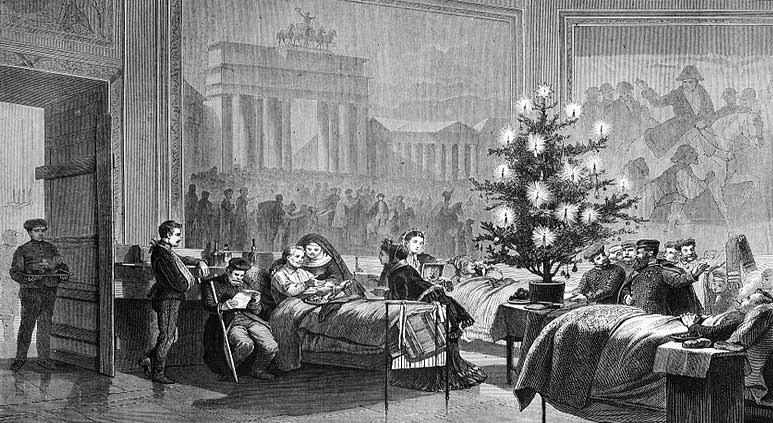
When we celebrate the winter season by decorating our homes with evergreen trees, wreaths, and boughs, we continue a tradition that has its roots in the earliest beginnings of humankind. Throughout the world, virtually every culture has used evergreens for some kind of celebration around the Winter Solstice – a yearly affirmation of the continuation of Life and renewal of our integral participation in all Life. By honoring the tree with decorations, we acknowledge Nature and its continuous cycles that sustain our lives.
After the last ice age, Europe was covered with immense forests. Because prehistoric people depended on the forests for food and shelter, fire, transportation, and tools, trees were an important part of their environment. In addition to their practical uses, trees seemed to embody the cycle of Nature itself—they grew and made sounds, gave birth to leaves and flowers and fruit, they “bled” when cut, and became old and died.
Trees symbolized fertility and life, strength, and steadfastness of spirit. Where evergreens were abundant, they became the trees more highly revered—while other trees lost their leaves and seemed to die during the winter, the evergreens stayed fresh and green, even through the most severe weather. That evergreens continued to hold their leaves and their “life” through the bleakness of winter resulted in their use as powerful symbols of the continuance of life. Evergreen boughs were reminders of the green plants that would grow again when the light-filled days of summer returned.
EVERGREENS IN ANCIENT CELEBRATIONS
Including trees in celebration and worship is common around the world. In China, sacred trees bore red banners with words of praise and thanksgiving on them. Greek and Roman goddesses and gods each had their special trees, which were draped in garlands of flowers.
The Winter Solstice marks the point of deepest darkness and, following, a return of the light that made Nature green and fruitful.
The use of evergreen trees for celebration at Winter Solstice began with the exchange of fir-tree twigs and the display of fir-tree twigs and branches on homes and in meeting places as a wish for the continuation of life. These twigs developed into bundles, then later into the whole tree.
Romans decorated their homes and temples with evergreen boughs. Winter Solstice was a special time of peace and equality when wars could not be declared, when slaves and masters could eat at the same table.
Eqyptians brought green date palm leaves into their homes to symbolize life’s triumph over death.
European Druids tied apples to the branches of oaks and firs to thank the god Odin for blessing them with fruitfulness, and also made offerings of cakes shaped like fish, birds, and other animals. Lighted candles, honoring the sun god Balder, were placed on the boughs. The Druids used evergreen holly and mistletoe as symbols of eternal life, and placed evergreen branches over doors to keep away evil spirits.
Late in the Middle Ages, Germans and Scandinavians placed evergreen trees inside their homes or just outside their doors to show their hope in the forthcoming spring.
THE FIRST CHRISTMAS TREE
Legend has it that the tradition of decorating trees to celebrate Christmas began with Reformation leader Martin Luther.
One clear, crisp Christmas Eve, around the year 1500, Luther was walking home through the woods. He paused for a moment in a grove of tall pine trees to gaze at the beauty of the starry sky. The fragrance of the pines reminded him of incense and the wind in their branches sounded like a congregation at prayer. From where he stood, it seemed like thousands of stars had settled on snow-dusted branches. Luther brought a small fir tree home and covered with small candles so he could share this story with his children. He lit the candles in honor of the birth of Christ.
The first Christmas tree actually documented occurred in 1605 in Strassburg, Germany. It was without candles, but decorated, as the Druids did, with bright red apples.
The Christmas tree migrated next to Austria and France, and then to England. When Queen Victoria of England married Prince Albert of Germany in 1840, he brought to England his German Christmas tree, which was by then covered with candles and hand blown glass ornaments. Pictures of the Queen and her family around a tabletop tree appeared in the newspapers, and soon all England had similar trees.
THE CHRISTMAS TREE IN AMERICA
The Christmas tree became the central focus of holiday celebrations in American homes a few years later when Gody’s Lady’s Book published a drawing of a family around a Victorian decorated tree. The Christmas tree may have come to the United States as early as the late-1700s, with German soldiers who were hired to bolster English troops during the American Revolution. According to legend, on the bitter cold Christmas Eve of 1776, at Trenton, New Jersey, the presence of a candlelit evergreen tree so reminded German soldiers of home that they abandoned their guard posts to eat, drink and be merry. George Washington attached that night and defeated them, turning the tide for the Revolution.
COMMERCIAL CHRISTMAS TREES
The commercial Christmas tree market began in 1851 when Catskill farmer Mark Carr hauled two ox sleds of evergreens into New York City and sold them all. By 1900, one in five American families had a Christmas tree, and 20 years later, the custom was nearly nationwide.
Christmas tree farms began during the depression. Nurserymen couldn’t sell their evergreens for landscaping, so they cut them for Christmas trees. Cultivated trees were preferred because they had a more symmetrical shape than wild ones.



